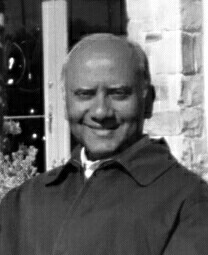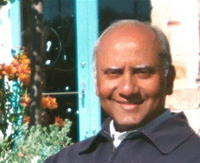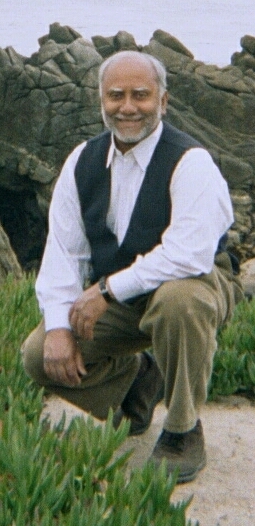
Call to
Community Service:
Reflections on
community
involvement
in modern era
The "Call to Serve" has taken me down paths I could never have foretold 36 years ago, paths that have convinced me that service is of critical importance to the health of not only each individual, but also that of each community.
The emotional and material chaos stemming from not having a stable abode during the first four years of my life after my family was displaced by the Second World War from the Middle East, where my father was a migrant clerical worker from India, led me first to economics for solutions. I wanted to understand and be part of addressing life's economic conditions and dislocations, and to help people help themselves.
I know now that this desire to understand and help was all part of my journey to heal myself.
While the study of economics gave me insights into the strengths of both traditional economies, and of economic systems based on individual choice and competitive market forces, I soon recognized that I would never master the mathematical methods at the heart of modern economics.
So, I shifted my focus to journalism, convinced of its important role in facilitating development. I took a loan from my brother [Dr. James Chacko Daniels], a Northwestern University medical graduate who was a doctor in Chicago, to study journalism in the United States. After getting a master's from Northwestern, I paid off the loan, working for about four years as an Assistant Editor for an Asia Foundation publication here in San Francisco between 1968 and 1972, writing about developments in Asia.
By this time, although I was 29 years old and had studied economics and journalism and had four years of experience, I was still searching for something that would make it all click for me.
In 1972, at the residence club that I was staying in San Francisco, I met a person who had just finished a year as a Volunteer In Service To America, the U.S. government's domestic version of the Peace Corps.
Her joy in having been able to help people help themselves as a VISTA volunteer was a welcome contrast to all the dissatisfied folks around me. Listening to her, I was convinced that community service work would tie together the various strands of my experience and training with my unfulfilled desire to help people help themselves.
So, at the age of 30, I became a national VISTA volunteer and was assigned to Grand Rapids, MI, after a brief period of community service training in Chicago. My first year as a VISTA in 1973-74 took me out of my personal shell and the isolation I lived in as I got down into the trenches helping people help themselves.
It saw me first participating in painting bees and then graduating to organizing painting bees and working with neighborhood associations, urban revivalists, and landlord and tenant groups on an urban homesteading initiative to save houses for people. In one case, I helped mobilize the U.S. Navy's Seabees, the St. Vincent de Paul Society, and several other helpful groups and individuals to save a house for a family about to be displaced.
I found it to be the most eventful and satisfying year of my life.
I met my wife-to-be during that year. Marriage to a Midwesterner refocused my work interests from Third World development to long-term work in the trenches of the War on Poverty in the U.S. To make a long story short, after a four-year gap, I became a VISTA again, this time in California for four additional years. My wife co-enrolled with me as a VISTA for one of those years.
My final VISTA assignment was at the Center for Independent Living in Berkeley, where I helped build and organize ramps for wheelchair users so that they could fully participate in America's mainstream. I worked at CIL for 14 additional years during which I helped start the Jobs for Homeless Consortium in 1988. In 1995, Job Consortium became an independent non-profit agency.
Over the years, I have put my study of economics and journalism to good use in my community service work in the form of program and human resource development; new approaches to serving homeless jobseekers focusing on client-centered services; service integration; fast track methodologies to address homeless persons' time horizons; multi-agency collaborations; linking employers and jobseekers; job fairs; grant proposals; manuals; flyers; brochures; newsletters; and presentations.
However, I continue to believe that without my VISTA volunteer experience I would not have been able to tie it all together at the individual client level, at the community level, and to each other.
My community service experience healed me internally and integrated me externally.
I would like to share with you our vision at Jobs Consortium to show how service experience and private perceptions affect public discourse.
0ur vision of the future is that millions of our homeless brothers and sisters--America's Frontline People--are employed.
But who are they, these homeless persons we call America's Frontline People? The statistics of our work at Jobs for Homeless Consortium are many and they would provide one answer. No, I am not going to bore you with statistics. I want to share with you, instead, an answer that reflects what I have really learned about homeless persons and about the average American.
So, who are these homeless persons?
Our experience tells us they are people who have fought our wars and kept our fragile peace; built our bridges, roads, houses, hospitals, offices; driven our trucks and buses; grown, harvested, prepared, and served our food; worked in our factories; written our poems; played or sung our songs; kept our books; taught and raised our children; nursed us or provided personal care when we couldn't care for ourselves; built our spaceships and high-tech toys... America's Frontline People.
They are our brothers and sisters. And they are us.
People in need, I have discovered in three decades of non-profit and community service work, are not only people like us, they are us. That is also why it is so very true to say that in any interaction between helper and those getting help, the person getting the most out of it is the helper. A significant proportion of our staff at the Jobs Consortium has been formerly homeless persons who are in recovery from addiction.
As you know, service is an important aspect of the Twelve Step approach to recovery from addiction. People in recovery know the truth very well that service is critical to the individual's recovery.
In my vision of society, answering the "Call to Serve" not only helps integrate the helper internally and with the community, but also assures the helper we live in a caring society, and we ourselves will be cared for.
And my community service experience tells me that answering the "Call to Serve" is of critical importance to any community's recovery . . . .
(Excerpted from a presentation to: Northwestern University Bay Area Alumni Club, September 29, 2004.)
An avid reader's comment about
Michael Chacko Daniels'
handcrafted books:
they look like little treasures."
--Brenda Coleman
a work of art in itself.
Click here to view a digital version of
Click here to view a digital version of
______ * ______
Michael Chacko Daniels' website,
US-India Writing Station?
If not, please do and be sure to
bookmark it. If you wish to
refer others to it, here's the URL:
 Feel free to visit, and explore: Fiction, Poetry, Community Service, Homeless, Commentary, & Discussion On The Road To Remaking The World We Live In . . . San Francisco, Grand Rapids, Evanston, Bombay, Kerala, Oakland, Berkeley, Monterey, Bangalore, Calcutta . . .
Feel free to visit, and explore: Fiction, Poetry, Community Service, Homeless, Commentary, & Discussion On The Road To Remaking The World We Live In . . . San Francisco, Grand Rapids, Evanston, Bombay, Kerala, Oakland, Berkeley, Monterey, Bangalore, Calcutta . . .Feel free to share the above link with others.
Sing an Indian Name, on Denver Syntax's free online magazine?
If not, here's the URL:
http://www.denversyntax.com/issue5/fiction/daniels/indian.html
You are invited to visit
New River Free Press International's
Career Visions for a Small PlanetCheck Out the Visions of
People Remaking Our Planet
Issue #1: Valerie Street
Issue #2: Hong Hunt
Issue #3: Ian C. Dawkins Moore
Issue #4: Peter Lee Kline
Issue #5: Ralph Dranow
Issue #6: Joseph Kaval
Issue #7: Quentine Acharya
Issue #8: Narendra Jadhav
Issue #9: Trash Pickers of Grand Rapids
Issue #10: Amanda Gerrie
And the following
Popular History Pages
/housing-conspiracies-michigan/
/open-housing-grand-rapids-1976/
/cities-survival-william-thrall/
/faith-society-father-ed-monroe/
/faith-society-praying-polish/
/zoo-cruelty-animals-michigan/
/food-coops-for-a-small-planet/


